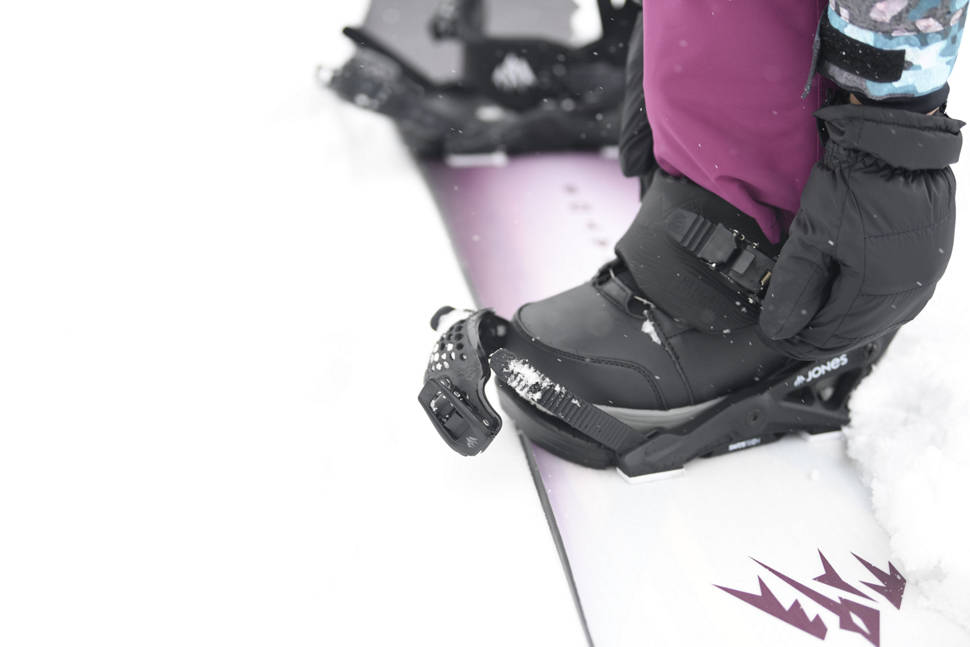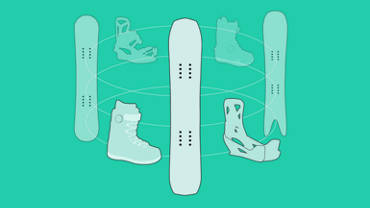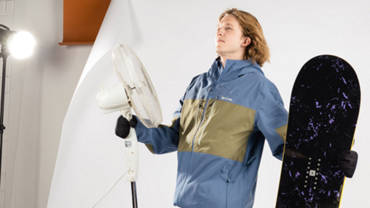List of contents
- A short video on how to mount your snowboard bindings
- A list of what you need to mount your snowboard bindings
- A step-by-step guide to mounting your snowboard bindings
- A step-by-step guide to mounting Burton EST bindings
- Which foot is in front?
- How do I differentiate between my right and left bindings?
- What is the snowboard stance?
- What is the best angle for my snowboard riding style?
- How to find the correct width between your snowboard bindings
- How to position your bindings correctly on your snowboard
- Test the mounting of you bindings
Our how-to video of snowboard bindings
Watch our short video and learn how to mount your snowboard bindings. You'll find detailed information and step-by-step instructions in the text below.
A list of what you need to mount your snowboard bindings:
- Snowboard
- Bindings
- Boots
- Screwdriver or snowboard tool
- Screws (included with the bindings)
- Calculator
- Measuring tape
A step-by-step guide to mounting your snowboard bindings:
- Place your snowboard on a flat surface with the nose facing forward.
- Position your bindings the correct way around on the snowboard. More information.
- Remove the baseplate cover to adjust your bindings.
- Adjust to the desired degrees. More information.
- Choose preferred inserts and place your bindings there. More info.
- Screw your bindings to the inserts and put the cover on your baseplate. More information.
- Buckle the boot into your bindings and check that all straps are centred. More information.
- Your boots should not extend past the heel or toe ramp.
- Check that the binding does not wobble and whether the stance you have set feels comfortable.
A step-by-step guide to mounting Burton EST bindings
- Place your snowboard on a flat surface with the nose facing forward.
- Use a screwdriver to push out the rubber covers of the channel.
- Place the inserts (black) in the channel.
- Adjust the toe ramp to your boot, so your toes do not stick out over the binding.
- To do so, lift the front part of the footbed slightly and slide it to the desired position.
- A slight downward pressure locks the position.
- Position the binding over the inserts and screw it on loosely at the recesses on the sides of the bindings.
- The angle indicators on the channel system are located directly on the board and not on the bindings.
- Move the bindings until the desired angle is visible in the small recess in the baseplate.
- Now centre your bindings to prevent your toes or heel from touching the snow while riding.
- Tighten the screws of the bindings.
- Check that the bindings do not wobble and the stance you have set feels comfortable.
Note: Burton EST bindings are only compatible with the Channel System.
All other Burton bindings can be used with any standard system.
Basic knowledge about the settings of snowboard bindings.
Which foot is in front?
Knowing whether you are facing Goofy or Regular on the snowboard is crucial. To find out, you can have another person push you slightly from behind while standing parallel. The first foot you step forward with is usually the foot that is at the front of the snowboard.
Goofy riders have their right foot in front, while regular riders have their left foot in front.


How do I differentiate between my right and left bindings?
Mount the bindings with the ratchets facing outwards.
If you are a regular rider, place the right binding closer to the nose. If you are a goofy rider, position the left binding in front.

What is the snowboard stance?
Depending on whether you prefer to ride on the slopes, in the park, or in deep snow, the position of your bindings needs to be adjusted. This includes the positioning, the angle, and the distance between your bindings. The snowboard stance is the result of all these adjustments.
What is the best angle for my snowboard riding style?
Neutral stance is best for beginners to practice forward riding and controlled turns.
- Front foot: +12° to +15°
- Rear foot: 0°

Forward stance is for advanced riders, carving, and high-speed runs.
- Front foot: +12° to +21°
- Rear foot: +3° to +6°

With duck stance, both bindings are mounted at an angle that points outwards. This makes it much easier to ride switch, i.e., with the other foot in front. In addition, with this stance, you can bend your knees more deeply and cushion hard landings more effectively.
- Front foot: +9° to +15°
- Rear foot: -6° to -12°

Tip: Bindings have degrees of angle indicated on the discs supplied. These usually range from -20 to +20 degrees. First, find the 0° angle and turn the binding to the desired number.
How to find the correct width between your snowboard bindings
The gap between bindings is measured from the centre of the disc and is determined by your riding style and the length of your board.
A wider distance provides more control and stability. A smaller one makes it easier for you to build up rotational speed, which can be an advantage for tight turns and spinning tricks.
The following formula suggests a well-fitting stance for you:
Your size x 0.33 = distance between the bindings. However, each rider has personal preferences. Adjust the width if you feel uncomfortable with it.
How to position your bindings on your snowboard
The positioning of the bindings determines how much distance the bindings have to the nose and tail of the board. Each snowboard is designed for a specific riding style, and that determines the positioning of the bindings to a degree.
Beginner and All-Mountain Snowboards
Beginner and all-mountain snowboards usually have their bindings set slightly back. This position is perfect for riding in most terrain and learning your first turns.
Freeride Snowboards
The inserts of freeride snowboards are positioned further back. This automatically lengthens the nose, and you enjoy more floatation in powder with less effort.
Know-how: This is known as a setback. The inserts are placed further back on the snowboard, i.e., offset to the rear. This results in the term setback.

Freestyle Snowboards
Freestyle snowboards not only feature a symmetrical shape, but the positioning of the bindings is also centred. This mounting type offers you the same riding feeling switch as it does forward.
Attention: Avoid mounting your binding offset to the front.
Test the mounting of your bindings
Put on your boots and step into the bindings to test your settings. Nothing should wobble, and the bindings must be firmly attached to your snowboard.
Straps
The straps of your bindings should be centred across your boots. If necessary, you can adjust the length of the straps.
Toe Ramp
Adjust the toe ramp - the front part of the baseplate - to the length of your boots. This ensures that your toes won't drag in the snow while riding.
Highback
Your highback should be aligned parallel to the heel edge of your snowboard. This allows for better power transmission.
Forward lean
You can also adjust the forward lean of your highback. The further forward, the faster your snowboard will react. However, especially as a beginner, be aware that too much of an angle is very demanding to ride, as you will have constantly bend your knees more.
This video explains how to mount the bindings and adjust them to your boots.
If you are still looking for suitable bindings, the Buyer's Guide and our Product Finder provide a lot of information and expert tips. Staff in our Shops and Customer Service are always happy to support you with personal assistance. Check out the Blue Tomato Rent-Your-Ride service if you want to try out a new setup before you get your own.
More information:
 Garanzia
Garanzia 



